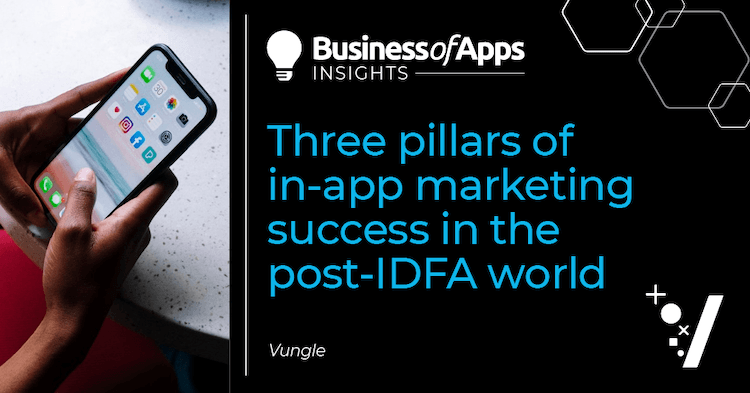
Since the pandemic began, our mobile phones have provided the main source of entertainment for most of us. As a result, despite an initial dampening of mobile ad spend due to Covid, forecasts for mobile advertising growth look promising. In fact, close to 90 percent of adult smartphone users are now spending over four hours a day on their phones, the vast majority of which is spent in apps – just check your Screen Time analytics if you think that’s farfetched! With app usage, user engagement and advertising potential all on the upswing, the last thing the industry expected was for Apple to throw a spanner in the works.
Although Apple granted mobile advertisers and mobile app publishers a temporary reprieve – delaying implementation to allow more time to prepare – its new App Tracking Transparency (ATT) policy will come into force in early spring. The change – which will make its unique ‘identifier for advertisers’ (IDFA) something users will need to opt-in for being tracked for advertising, rather than opt-out of – will certainly have a massive impact. Without the ability to identify users of iOS14 operating systems, advertisers will find it harder to target, optimize and attribute campaign performance to the individual. But it’s not all doom and gloom for the mobile advertising industry. In fact, we’re seeing new creative momentum, as well as an increased focus on probabilistic attribution and contextual targeting. The industry has switched firmly into can-do mode.
When Apple’s privacy changes come into force, the emphasis will be on how well app marketers understand how to use creative and other tools to drive performance. App marketing success in 2021 will be characterized by how well marketers can master three elements.
Create emotional resonance with ads
Emotion is one of the most powerful drivers of consumer decision-making and purchasing behaviors. Advertising research shows that consumers’ emotional response to an ad influences their intent to buy a product much more than the ad’s content does. What’s more, the richer the emotional content of a brand’s mental representation, the more likely the consumer will be loyal to the brand.
To draw consumers to a brand and improve loyalty, in-app marketers will have to focus on designing creative that connects emotionally with their audiences, such as by matching the feelings kindled by the content that person was engaging with before seeing the ad. They can do this by picking up on the cues available to them. These include:
- The category of the app. Will the ad appear in a gaming context, a health & fitness app or a dating app? These cues tell us what type of content is being consumed, and whether it’s entertainment, educational, lifestyle or social in nature. Food and wine app audiences are unlikely to connect emotionally with juice cleanse ads.
- The mood of the app. Is the user transported into a minimalist setting or one jam-packed with colours and impulses? Is it cheerful and comical, or a serious and intense adventure? These aspects tell us the tone the ad should complement in order to fit cohesively into the app’s overall experience.
- The artistic style of the app. Does the look and feel of the app take users to a different time, place or even visual reality? Are they in the 20s, 80s or a dystopian future? Are the graphics cartoonish, fantastic or anime? These characteristics tell us the visual style the ad should strive to match in order to create a strong emotional harmony between the ad and the game experience.
- The behaviors the app elicits. If the app is a game, is the user playing in a competitive environment where they can win or lose? Or are they building their own virtual environments, where they can look upon their growing cities or flourishing farms with pride? Are they being social within the game, inviting friends to play or using emojis to express themselves? These cues tell us about the emotional drivers present in the user’s session.
Understanding these mechanics will help marketers not only recognize the context of the ad but also identify and mirror the emotions driving the app experience, which in turn will help them align ad creative and placement with it.
Optimize for probabilistic attribution and contextual targeting
When it comes to fine-tuning in-app advertising effectiveness there are two strategies mobile marketers can leverage.
The first is probabilistic attribution. When users decline to opt-in to ad tracking, advertisers will have the SKAdNetwork – Apple’s attribution solution for iOS14 – to fall back on. With SKAdNetwork, networks register the ads they’re displaying to users with Apple, and if a user engages with the campaign, Apple notifies the network that their campaign was successful. However, this notification doesn’t include user or device-identifying information. While this gives advertisers access to conversion data, it doesn’t share any user-level campaign data, and restricts campaign performance data for down-funnel events.
This is where probabilistic attribution comes into the picture. Through probabilistic attribution, advertisers can assign campaign membership probabilities to a user based on attributes, behaviors, and the following data:
- Anonymous user-level in-app data such as customer-generated user ID, the revenue generated by the user within the app and in-app events the user completed
- SKAdNetwork postbacks containing campaign ID, Source App ID and Conversion Value
- Ad network-reported data, which are mainly installs, impressions and spend
These are some of the insights that mobile app marketers can rely on to better understand the user.
The other side of this coin is contextual targeting. Contextual signals indicate to advertisers and their tech partners what kind of ad creative to deliver within the context of the app. Part of this is on the level of the user, in the form of anonymized user behavior data – these are the cues mentioned above – that help create an emotionally coherent experience. Unsurprisingly, compelling experiences lead to better ad performance.
Fire Up Your Growth!
Moburst propelled leading brands like Google, Reddit, and Uber to the next level. Let’s ignite your Success journey today!
Claim Your FREE Growth Fuel!Another element of contextual targeting relates to the device. Device-based contextual signals such as the strength of network connection or battery level can help optimize ad placement without the need to know anything about the individual. A dying battery, low storage space or poor network connection are all indicators that the user is unlikely to download a data-heavy mobile app – so an ad for such an app will be a hit or miss.
When it comes to understanding performance of a contexted ad in a post-IDFA world, some unknowns remain. For instance, we now know that Source App ID and Conversion Value are only passed back if a so-called ‘privacy threshold’ is met, but Apple still hasn’t defined what the privacy threshold is or what needs to be done to satisfy it. Only time will tell how publishers can use Conversion Value and other metrics to define performance metrics.
Marry context with ad creative
Until now, advertisers didn’t need to pay much attention to contextual signals within an app to drive performance – they knew enough about the user to achieve ad performance goals without having to invest in new creatives. But without the ability to personalize ads to the individual based on their IDFA, this will change. Going forward one of the best ways for advertisers to make in-app ads more effective is by combining contextual signals within an app with ad creative. When an ad’s creative and the context of its placement are aligned, the ad will be more likely to connect with consumers on an emotional level and influence purchasing decisions.
A big difference between the previous, IDFA-based personalization systems and those now coming into force will manifest in timing. Previously, a user’s likely engagement with an ad could be determined based on their past preferences – going forward, this will be determined in the now, and that means just seconds! Indeed, humans’ attention span is between 6-8 seconds, which is less than the 9 seconds attention span of a goldfish, according to Microsoft research. App marketers need to make sure they create enough emotional connection in this short timeframe to move their audiences to engage with the content.
By making connections between a person’s current preferences based on the ad’s context and the type of content that is most likely to engage them in that moment, it is possible to achieve better performance through better creativity. And IDFA or not, creativity should never be in short supply.
The mobile advertising industry has plenty of support from creative studios and new technologies that help produce adaptive creative, with multiple creative variants that can be directly tested in campaigns. The power of visually compelling creatives, tailored to the right context and supported by technology, will help advertisers draw consumers in, build brand loyalty and improve performance metrics such as click-throughs and conversion rates.
Conclusion
Mobile app advertisers and publishers have never known a reality other than an industry in fast-paced, constant change. But no matter the mechanism for targeting ads for users, mobile marketers have always understood the power of creativity to connect with audiences on an emotional level, and have been applying this fundamental principle to different contexts as technological change has forced their tactics to evolve. This time will be no different.
The key thing to remember as the industry embarks on its post-IDFA journey is that emotional resonance is at the heart of creating rich, compelling ad experiences, and this can only be achieved through the right combination of ad creative and ad context. At the same time, picking up on contextual cues, anonymised user-level and device-level signals will be key to fine-tuning targeting, ad placement and attribution. In a post-IDFA world, driving user engagement and increasing returns will ultimately come down to app marketers’ ability to create powerful and memorable in-app experiences that resonate at the right time and place.











